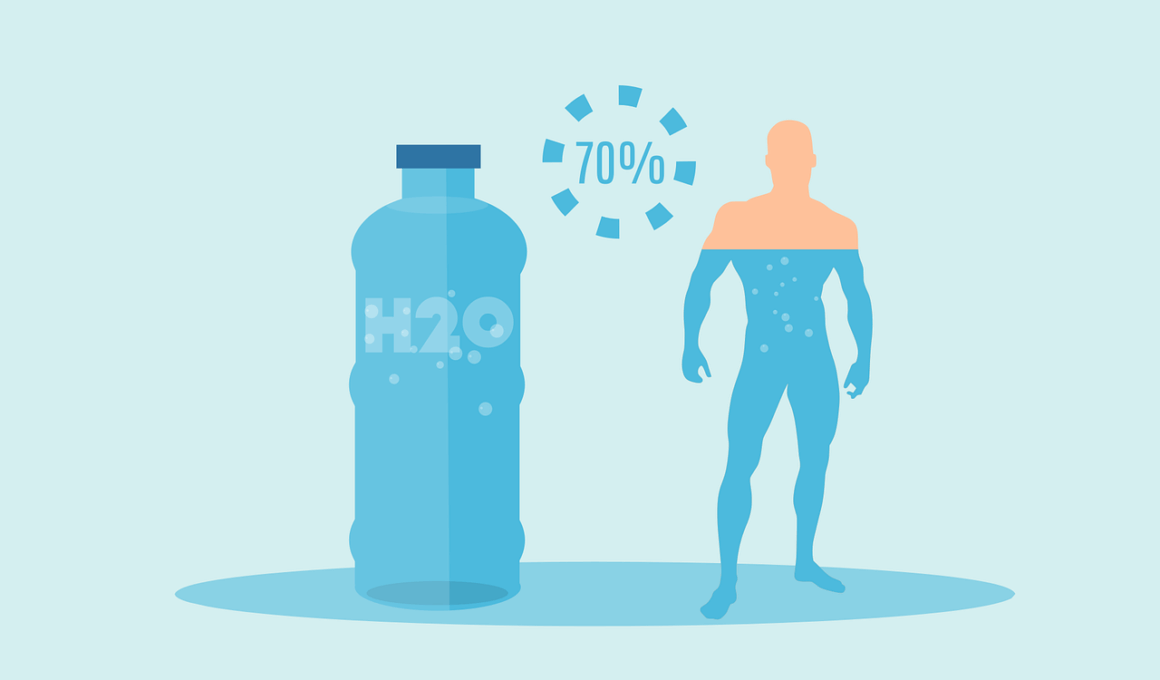Hydration Strategies to Combat Muscle Cramps in Triathlon
Triathletes understand that hydration is critical for performance, particularly in preventing muscle cramps during races. Cramps can occur due to loss of fluids and electrolytes from sweating, leading to increased muscle tension. To maintain peak performance, it’s essential to develop a hydration strategy tailored to your individual needs. Start by assessing your fluid loss during training sessions. This can easily be done by weighing yourself before and after exercise to determine how much fluid you lose. A good rule of thumb is to consume about 16-24 ounces of water for every pound lost. Additionally, consider incorporating electrolyte-rich drinks to restore sodium, potassium, and magnesium levels. Sports drinks often contain these vital components. Be cautious, however, not to overhydrate as this can lead to hyponatremia, a dangerous condition resulting from a dilution of sodium in the blood. Instead, focus on a balanced intake of hydrating fluids before, during, and after your workouts. Monitor your body’s response and adjust your hydration plan accordingly. Test different hydration strategies to find what works best for you to optimize performance and prevent muscle cramps. Passion and preparation are key!
Moreover, planning hydration breaks during your triathlon can significantly help mitigate the risk of muscle cramps. Integrate scheduled drinking intervals into your training regimen. This practice will create a habit so that hydration becomes second nature while racing. A good practice is to take small sips every 15-20 minutes rather than waiting until you feel thirsty, as thirst is often a late indicator of dehydration. Carrying a water bottle or hydration pack allows for easy access to hydration while on the move, and it’s worth experimenting to find the best hydration tool for your comfort during races. Keep an eye on the temperature and humidity conditions on race day, as these factors influence your hydration needs. In cooler weather, you may sweat less, requiring less fluid intake, while hot, humid conditions demand more frequent hydration. Remember that hydrating before a race is equally important! A good pre-race hydration strategy should begin at least 24 hours before your event. Drip the recommended fluids into your system gradually to ensure you start the race properly hydrated while minimizing restroom breaks mid-run. Each method should be tailored to suit your schedule!
Electrolyte Balance
Maintaining proper electrolyte balance is another key component of an effective hydration strategy for triathletes aiming to avoid muscle cramps. Electrolytes play a crucial role in muscle function and cramping, as they help regulate nerve impulses and muscle contractions. Sodium, potassium, calcium, and magnesium are the primary electrolytes that need to be monitored during training. Consuming sports drinks that contain these electrolytes can be beneficial, especially during long training sessions. Not only do they replace essential minerals lost through sweat, but they also help regulate fluid balance within the body, thus supporting optimal muscle function. Additionally, it can be useful to evaluate your diet to ensure you are getting sufficient electrolyte intake. Foods such as bananas, oranges, dairy products, and leafy greens are excellent sources of potassium and calcium. Consider incorporating these into your pre-training meals or snacks. Within your hydration plan, strive to combine fluids with whole foods that provide electrolytes. This combination reduces the risk of cramping and maintains energy levels during those challenging triathlon events. Ultimately, understanding the role of electrolytes in the hydration equation can help keep cramps at bay while you push toward your goals.
To further combat muscle cramps during triathlons, develop a personalized hydration plan based on experience and body responses. Begin by analyzing your results from completed triathlons or significant training sessions, noting fluid intake and hydration effects on performance. This data can help you balance hydration amounts, electrolyte needs, and food intake during races. For a more tailored approach, consider working with a nutritionist or coach specializing in endurance sports. Integrating their expertise into your training can provide insights and strategies that you may not have previously considered. Pay attention to individual variations in sweating rates among athletes to discern your own hydration requirements for race day. Each athlete’s needs can differ considerably, influenced by several factors including fitness level, climate conditions, nutrition, and race duration. Additionally, training in conditions similar to those expected on race day can help you gauge the right hydration approach effectively. As you develop your strategy, remember to stay flexible in your plan to adjust it based on on-the-ground feedback during the event. Constant improvements lead to significant changes, so make adjustments as needed for optimal performance.
Fluid Sources
Choosing the right fluids is also a critical consideration when establishing your hydration strategy to prevent muscle cramps in triathlons. Water is essential, but sports drinks can provide additional benefits that plain water cannot. In your hydration assortment, concentrate on beverage options that supply both hydration and nutrients. Notably, drinks high in carbohydrates can provide energy to fuel your muscles while hydrating. However, be cautious about high sugar content in certain commercial sports drinks that may lead to gastrointestinal discomfort during races. As an alternative, you can craft your own homemade beverages utilizing water, fruit juices, and a pinch of salt to develop an effective hydration formula without excessive sugars. Additionally, coconut water is a natural choice loaded with hydration and essential electrolytes, perfect for recovery or as an on-the-go drink. Try different fluid types during training to determine what sits best with your stomach and fuels your performance without negative effects. Document your findings to create a well-rounded hydration plan that gives you the best chance for success on race day without the hindrance of cramps. Proper planning is essential!
Lastly, it’s essential to listen to your body during training and competitions to fine-tune your hydration strategy. This means recognizing when you might need more or less fluid based on how you feel and your performance levels. The goal is to create a personalized hydration strategy rooted in responsive behaviors during long runs and transitions. Keeping a journal of hydration intake and symptoms can assist in tracking which strategies lead to optimal outcomes. Mental training, scouting hydration stations on the triathlon course, and practicing quick drinking techniques can also be part of your preparation. Practice taking in fluids while transitioning between swim, bike, and run sectors, as these aspects can make or break your race. Engaging in these strategies will reduce anxiety about when and how to hydrate efficiently during the actual triathlon. Familiarity with your hydration approach during the race will make you feel more confident in your capabilities. By refining your hydration plan, you can tackle muscle cramps and bid farewell to potential setbacks during your multi-sport events, allowing you to focus on finishing strong and enjoying your race.
Conclusion
In conclusion, optimizing hydration strategies is vital for triathletes who wish to combat muscle cramps effectively. Adopt a comprehensive hydration approach that includes regular fluid intake before, during, and after exercising. Integrate electrolyte-rich beverages and whole food sources into your diet to maintain proper balance. Establish a personalized hydration plan through continual evaluation of performance indicators, data, and self-awareness. Customizing your hydration strategy will empower you to understand your body and support your training goals while minimizing the risk of cramps. As a dedicated triathlete, remember that hydration is not a one-size-fits-all solution. Rather, it is a dynamic process that requires consistent attention and adaptation. Pay close attention to your fluid needs, and don’t hesitate to modify your approach as necessary. You can even try various hydration sources, from sports drinks to natural options. Ultimately, your dedication to finding the balance in hydration will pay off, enhancing your race experience and performance. Always approach your training with intensity and care, ensuring you’re prepared to face any challenges during your triathlon journey. Train hard, stay hydrated, and enjoy the thrill of competing!
Future Considerations
Staying informed regarding emerging hydration technologies and products may also enhance your performance as a triathlete. The sports nutrition industry is continuously evolving, offering new options that can refine your hydration experience and reduce the risk of cramping. Wearable hydration trackers are now available, enabling you to monitor your fluid intake and dehydration levels during workouts or races. These devices can provide real-time feedback, helping you make informed decisions about when and how much to drink throughout your training. Moreover, as research advances, new insights will emerge regarding the optimal combination of carbohydrates, electrolytes, and water for triathletes. It’s beneficial to stay updated on these trends, as they could influence your hydration strategy significantly. Engage with fellow triathletes and join forums or instructional workshops to share your successes and challenges within the realm of hydration. By studying the latest findings, you can implement evidence-based practices into your training, offering the opportunity to further improve your endurance and performance. In the end, hydration is just as important as training and preparation in keeping muscle cramps at bay, optimizing your triathlon experience.


